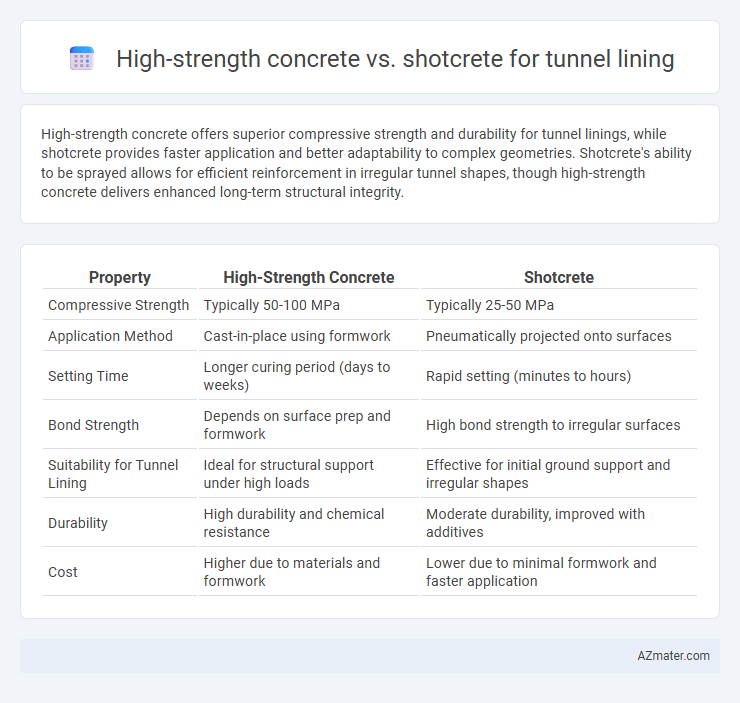High-strength concrete offers superior compressive strength and durability for tunnel linings, while shotcrete provides faster application and better adaptability to complex geometries. Shotcrete's ability to be sprayed allows for efficient reinforcement in irregular tunnel shapes, though high-strength concrete delivers enhanced long-term structural integrity.
Table of Comparison
| Property | High-Strength Concrete | Shotcrete |
|---|---|---|
| Compressive Strength | Typically 50-100 MPa | Typically 25-50 MPa |
| Application Method | Cast-in-place using formwork | Pneumatically projected onto surfaces |
| Setting Time | Longer curing period (days to weeks) | Rapid setting (minutes to hours) |
| Bond Strength | Depends on surface prep and formwork | High bond strength to irregular surfaces |
| Suitability for Tunnel Lining | Ideal for structural support under high loads | Effective for initial ground support and irregular shapes |
| Durability | High durability and chemical resistance | Moderate durability, improved with additives |
| Cost | Higher due to materials and formwork | Lower due to minimal formwork and faster application |
Introduction to Tunnel Lining Materials
High-strength concrete and shotcrete serve as essential materials for tunnel lining, each offering distinct advantages in structural stability and application efficiency. High-strength concrete provides superior compressive strength, enhancing tunnel durability under significant geological pressures. Shotcrete, applied pneumatically, allows for rapid placement and excellent adhesion on uneven surfaces, making it ideal for complex tunnel geometries and quick stabilization during excavation.
Overview of High-Strength Concrete
High-strength concrete (HSC) used in tunnel lining typically exhibits compressive strengths exceeding 50 MPa, offering enhanced durability and load-bearing capacity ideal for underground structures. Its dense microstructure reduces permeability, improving resistance to aggressive environmental conditions common in tunnel environments. Advanced mix designs incorporating supplementary cementitious materials and chemical admixtures optimize workability and early strength gain, making HSC a preferred choice for permanent tunnel support.
Understanding Shotcrete Technology
Shotcrete technology involves spraying a high-velocity mixture of cement, aggregates, and water onto tunnel surfaces, providing rapid application and excellent adhesion. High-strength concrete offers superior compressive strength and durability but requires formwork and longer curing times, making shotcrete more suitable for complex tunnel geometries and fast construction schedules. Advances in fiber reinforcement and admixtures have enhanced shotcrete's mechanical properties and crack resistance, positioning it as a preferred method for tunnel lining stabilization.
Key Material Properties Comparison
High-strength concrete offers superior compressive strength typically exceeding 70 MPa, providing excellent durability and load-bearing capacity essential for tunnel linings under high stress conditions. Shotcrete, applied pneumatically, features rapid setting times and high adhesion properties, crucial for conforming to irregular tunnel surfaces and enabling immediate structural support. Both materials exhibit low permeability and resistance to sulfate attack, but high-strength concrete generally achieves greater long-term longevity, while shotcrete excels in flexibility and application efficiency.
Installation Methods and Equipment
High-strength concrete for tunnel lining typically requires formwork, pumps, and cranes to achieve precise placement and compaction, ensuring structural integrity under high stress conditions. Shotcrete installation uses pneumatic spray equipment, allowing rapid application on irregular tunnel surfaces without extensive formwork, reducing setup time and labor costs. Equipment choice impacts project efficiency: traditional concrete methods suit large, uniform sections, while shotcrete excels in complex, curved tunnel geometries with faster cycle times.
Durability and Long-term Performance
High-strength concrete offers superior compressive strength and durability, making it ideal for tunnel lining in high-stress environments due to its resistance to chemical attack and abrasion. Shotcrete provides excellent adhesion and flexibility, allowing for quick application in irregular tunnel profiles, but may exhibit lower long-term durability without proper reinforcement and curing. Selecting between the two depends on project-specific factors such as environmental exposure, structural load requirements, and maintenance capabilities to ensure optimal long-term performance.
Cost Analysis: High-Strength Concrete vs Shotcrete
High-strength concrete for tunnel linings typically incurs higher material and formwork costs due to specialized mixers and molds, whereas shotcrete offers reduced labor and equipment expenses with faster application and minimal formwork. Shotcrete's versatility and accelerated construction time often lead to overall lower project costs despite potentially higher rebound waste and additional reapplication needs. Cost analysis should account for project scale, tunnel geometry, and accessibility to optimize economic efficiency between these two lining methods.
Environmental Impact and Sustainability
High-strength concrete for tunnel lining typically requires higher cement content, contributing to increased carbon emissions and environmental footprint compared to shotcrete, which allows for more precise application and reduced material waste. Shotcrete's ability to be applied pneumatically minimizes formwork use and excavation disturbance, enhancing sustainability through lower resource consumption and reduced construction time. Both materials offer durability, but shotcrete's spray application aligns better with eco-friendly construction practices by optimizing material efficiency and reducing greenhouse gas emissions associated with traditional casting processes.
Case Studies: Real-world Tunnel Applications
High-strength concrete exhibits superior compressive strength and durability in tunnel lining, as demonstrated in the Gotthard Base Tunnel, where it enhanced load-bearing capacity under extreme geostress conditions. Shotcrete offers rapid application and excellent adaptability to complex geometries, evidenced by its successful use in the Channel Tunnel for immediate rock stabilization during excavation. Case studies highlight that combining both materials, such as in the Seikan Tunnel, can optimize structural performance and construction efficiency in challenging tunnel environments.
Choosing the Optimal Lining: Factors to Consider
High-strength concrete offers superior compressive strength and durability, making it ideal for tunnel linings subjected to heavy loads and aggressive environmental conditions. Shotcrete provides rapid application and excellent adhesion to complex tunnel geometries, reducing construction time and labor costs. Key factors to consider when choosing between high-strength concrete and shotcrete include structural requirements, project timeline, accessibility of the tunnel lining area, and long-term maintenance demands.

Infographic: High-strength concrete vs Shotcrete for Tunnel lining
 azmater.com
azmater.com